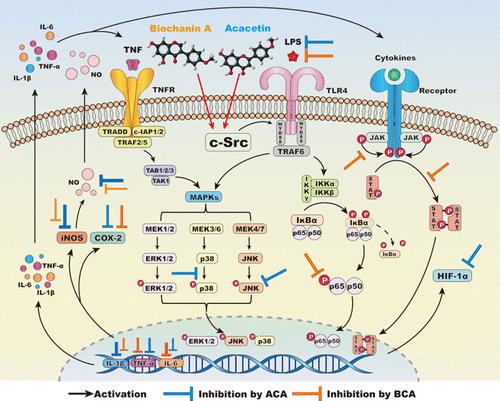当前位置:
X-MOL 学术
›
J. Agric. Food Chem.
›
论文详情
Our official English website, www.x-mol.net, welcomes your
feedback! (Note: you will need to create a separate account there.)
Anti-inflammation Mechanisms of Flavones Are Highly Sensitive to the Position Isomers of Flavonoids: Acacetin vs Biochanin A
Journal of Agricultural and Food Chemistry ( IF 5.7 ) Pub Date : 2024-09-17 , DOI: 10.1021/acs.jafc.4c05060 Yujia Cao 1 , Yee Joo Tan 2 , Dejian Huang 1, 3
Journal of Agricultural and Food Chemistry ( IF 5.7 ) Pub Date : 2024-09-17 , DOI: 10.1021/acs.jafc.4c05060 Yujia Cao 1 , Yee Joo Tan 2 , Dejian Huang 1, 3
Affiliation

|
Acacetin (ACA) and biochanin A (BCA) are isomeric monomethoxyflavones with different structural positions of the 4′-methoxy-phenyl group. Both of them are present in many commonly consumed foods, such as citrus fruits and vegetables, and have been discovered with anti-inflammatory activities, but their mechanisms of action are not clearly elucidated at the molecular level. Herein, we reported the structure–activity relationship of ACA and BCA regarding their potency in inhibiting nitric oxide (NO) production, proinflammatory enzyme expression, and mRNA expression of proinflammatory cytokines in the lipopolysaccharide (LPS)-induced RAW 264.7 cells. Furthermore, transcriptome analysis was conducted to map out the overall pathways impacted by these two isomers. Our results showed that ACA possessed higher suppressive activity in nitric oxide (NO) production (IC50 = 23.93 ± 1.74 μM for ACA and IC50 = 71.41 ± 8.07 μM for BCA), inducible nitric oxide synthase (iNOS) expression, and proinflammatory interleukin (IL)-1β mRNA expression, but lower inhibitory activity in IL-6 mRNA expression as compared with BCA. Although two compounds were revealed to bind to c-Src protein according to drug affinity responsive target stability (DARTS) and western blotting results, molecular docking and molecular dynamics (MD) simulation showed that they had different binding sites, which subsequently resulted in different signaling transduction. ACA primarily exerted anti-inflammatory activity through the mitogen-activated protein kinase (MAPK) signaling pathway, the tumor necrosis factor (TNF) signaling pathway, and the hypoxia-inducible factor (HIF)-1 signaling pathway, while BCA was particularly involved in the Janus kinase/signal transducers and activators of transcription (JAK/STAT) signaling pathway, the nuclear factor kappa B (NF-κB) signaling pathway, the TNF signaling pathway, and the toll-like receptor (TLR) signaling pathway. Moreover, two isomers remained stable in the cell culture medium and did not encounter the biotransformation process in RAW 264.7 cells. However, BCA exhibited insufficient cellular uptake ability and transport efficiency in macrophages compared to ACA. Taken together, ACA is more promising for controlling inflammation and worthy of further study for human use.
中文翻译:

黄酮的抗炎机制对类黄酮的位置异构体高度敏感:金合欢素 vs 生物素 A
Acacetin (ACA) 和生物素 A (BCA) 是异构体单甲氧基黄酮,具有不同 4′-甲氧基苯基的结构位置。它们都存在于许多常食用的食物中,例如柑橘类水果和蔬菜,并且已被发现具有抗炎活性,但它们的作用机制在分子水平上尚未明确阐明。在此,我们报道了 ACA 和 BCA 在脂多糖 (LPS) 诱导的 RAW 264.7 细胞中抑制一氧化氮 (NO) 产生、促炎酶表达和促炎细胞因子 mRNA 表达的效力的结构-活性关系。此外,进行了转录组分析以绘制受这两种异构体影响的总体途径。我们的结果表明,ACA 在一氧化氮 (NO) 产生中具有较高的抑制活性 (ACA 的 IC50 = 23.93 ± 1.74 μM,BCA 的 IC50 = 71.41 ± 8.07 μM)、诱导型一氧化氮合酶 (iNOS) 表达和促炎白细胞介素 (IL)-1β mRNA 表达,但对 IL-6 mRNA 表达的抑制活性较低与 BCA 相比。虽然根据药物亲和反应性靶标稳定性 (DARTS) 和蛋白质印迹结果显示两种化合物与 c-Src 蛋白结合,但分子对接和分子动力学 (MD) 模拟表明它们具有不同的结合位点,随后导致不同的信号转导。 ACA 主要通过丝裂原活化蛋白激酶 (MAPK) 信号通路、肿瘤坏死因子 (TNF) 信号通路和缺氧诱导因子 (HIF)-1 信号通路发挥抗炎活性,而 BCA 特别参与 Janus 激酶/信号转导和转录激活因子 (JAK/STAT) 信号通路、核因子 kappa B (NF-κB) 信号通路、TNF 信号通路、 和 toll 样受体 (TLR) 信号通路。此外,两种异构体在细胞培养基中保持稳定,在 RAW 264.7 细胞中没有遇到生物转化过程。然而,与 ACA 相比,BCA 在巨噬细胞中的细胞摄取能力和转运效率不足。综上所述,ACA 在控制炎症方面更有希望,值得进一步研究供人类使用。
更新日期:2024-09-17
中文翻译:

黄酮的抗炎机制对类黄酮的位置异构体高度敏感:金合欢素 vs 生物素 A
Acacetin (ACA) 和生物素 A (BCA) 是异构体单甲氧基黄酮,具有不同 4′-甲氧基苯基的结构位置。它们都存在于许多常食用的食物中,例如柑橘类水果和蔬菜,并且已被发现具有抗炎活性,但它们的作用机制在分子水平上尚未明确阐明。在此,我们报道了 ACA 和 BCA 在脂多糖 (LPS) 诱导的 RAW 264.7 细胞中抑制一氧化氮 (NO) 产生、促炎酶表达和促炎细胞因子 mRNA 表达的效力的结构-活性关系。此外,进行了转录组分析以绘制受这两种异构体影响的总体途径。我们的结果表明,ACA 在一氧化氮 (NO) 产生中具有较高的抑制活性 (ACA 的 IC50 = 23.93 ± 1.74 μM,BCA 的 IC50 = 71.41 ± 8.07 μM)、诱导型一氧化氮合酶 (iNOS) 表达和促炎白细胞介素 (IL)-1β mRNA 表达,但对 IL-6 mRNA 表达的抑制活性较低与 BCA 相比。虽然根据药物亲和反应性靶标稳定性 (DARTS) 和蛋白质印迹结果显示两种化合物与 c-Src 蛋白结合,但分子对接和分子动力学 (MD) 模拟表明它们具有不同的结合位点,随后导致不同的信号转导。 ACA 主要通过丝裂原活化蛋白激酶 (MAPK) 信号通路、肿瘤坏死因子 (TNF) 信号通路和缺氧诱导因子 (HIF)-1 信号通路发挥抗炎活性,而 BCA 特别参与 Janus 激酶/信号转导和转录激活因子 (JAK/STAT) 信号通路、核因子 kappa B (NF-κB) 信号通路、TNF 信号通路、 和 toll 样受体 (TLR) 信号通路。此外,两种异构体在细胞培养基中保持稳定,在 RAW 264.7 细胞中没有遇到生物转化过程。然而,与 ACA 相比,BCA 在巨噬细胞中的细胞摄取能力和转运效率不足。综上所述,ACA 在控制炎症方面更有希望,值得进一步研究供人类使用。































 京公网安备 11010802027423号
京公网安备 11010802027423号